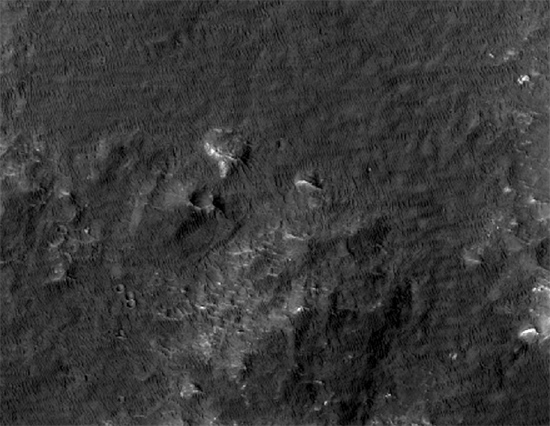|

Inside Eberswalde crater, one of
four proposed MSL landing sites.
Original image credit:
NASA/JPL/University of Arizona
Martians, Men and Machines
Apr 08, 2011
Is there,
or has there ever been, life on the
Red Planet? A new mission will try
to find out.On a
morning between November 25 and
December 18, 2011 NASA will launch
the
Mars Science Laboratory (MSL),
otherwise known as "Curiosity." The
new rover owes its handle to naming
contest winner Clara Ma from Lenexa,
Kansas.
Curiosity is five times
heavier than the Mars Exploration
Rovers "Opportunity" and "Spirit,"
with upgraded instrumentation,
including a high definition stereo
video camera. Additionally, a
tunable laser spectrometer can
identify a wide range of organic
compounds, as well as determine the
isotopes of different key elements.
The primary mission objective is
for Curiosity to travel through the
landscape within one of four landing
sites, searching for life, or
evidence of previous life, on Mars.
The space program has been working
on that project since the early
1970s when Viking 1 was launched
from Cape Canaveral on August 20,
1975, followed one month later by
Viking 2. On July 20, 1976 Viking 1
landed on Mars, preceding its twin
by almost exactly six weeks.
The essential reason for the
Viking landers was to look for the
same things that the MSL is designed
to look for. Viking 1 landed in the
western portion of Chryse Planitia,
while Viking 2 landed 6700
kilometers away in Utopia Planitia.
Both landers analyzed soil samples
in an attempt to locate respiratory
byproducts, but nothing conclusive
was found.
One could argue that any organic
substances that might have been in
reach of either Viking platform
could have been incinerated when the
descent engines blasted the landing
area with superheated gases. To
avoid this potential problem,
Curiosity's descent module is
designed to hover over the surface,
while the rover is lowered by an
onboard crane. The module will then
engage thrust and fly some distance
away before crashing.
The air is 100 times thinner on
Mars and averages 75 degrees colder
than Earth. The environment appears
to be bone dry, with only some
suggestive experiments by the
Phoenix lander to indicate the
possible presence of water ice.
Without the presence of water in the
form of subsurface ice deposits, the
chances of finding life are admitted
by all concerned to be slim.
On Mars, deep channels and other
structures are thought to be caused
by water flowing on the surface,
although it was "millions of years
ago." Chemicals that form in the
presence of water on Earth are
presumed to have formed on Mars by
the same process. Despite the
contradictory evidence of mineral
deposits that would be destroyed by
water, such as olivine, the flowing
water hypothesis continues to guide
theories of Martian areography.
In 1997, the Mars Global Surveyor
(MGS) found
outcrops of layered rock
extending for thousands of
kilometers. Hundreds more images
uncovered rock layering in other
locations. Since many of the layers
are similar in thickness, NASA
scientists conclude that the strata
are sedimentary. They might have
built-up in water and then been
eroded by wind. For that reason,
Curiosity's landing sites are in
areas that are extensively layered.
The active electrical forces that
almost destroyed Mars at some time
in the recent past are, of course,
ignored by consensus science. Until
electromagnetic forcefields, plasma
discharges, and double layers are
studied and understood by planetary
scientists, no theory about Mars
will be satisfactory.
Mars tells a story that includes
powerful plasma discharges on a
massive scale. Vast areas show signs
of excavation down to six kilometers
below the mean elevation. Some of
the shattered rock was accelerated
electrically into space; some fell
back to the surface, where it was
electrically sorted and deposited in
hardened layers. Rather than water,
it was probably lightning that
layered Mars.
Stephen Smith
Thanks to
Eric Frank Russell for
inspiring the title.
 New
DVD New
DVD
The Lightning-Scarred
Planet Mars
A video documentary that could
change everything you thought you
knew about ancient times and
symbols. In this second episode of
Symbols of an Alien Sky, David
Talbott takes the viewer on an
odyssey across the surface of Mars.
Exploring feature after feature of
the planet, he finds that only
electric arcs could produce the
observed patterns. The high
resolution images reveal massive
channels and gouges, great mounds,
and crater chains, none finding an
explanation in traditional geology,
but all matching the scars from
electric discharge experiments in
the laboratory. (Approximately 85
minutes)
Video Selections
Order Link
|





 New
DVD
New
DVD

